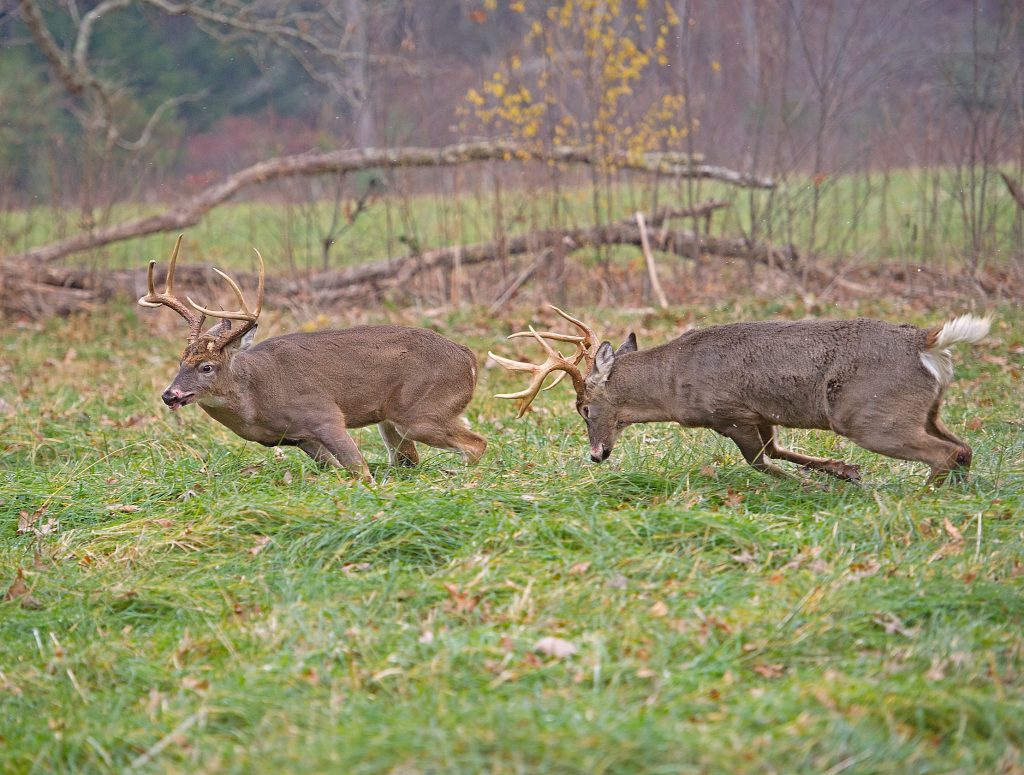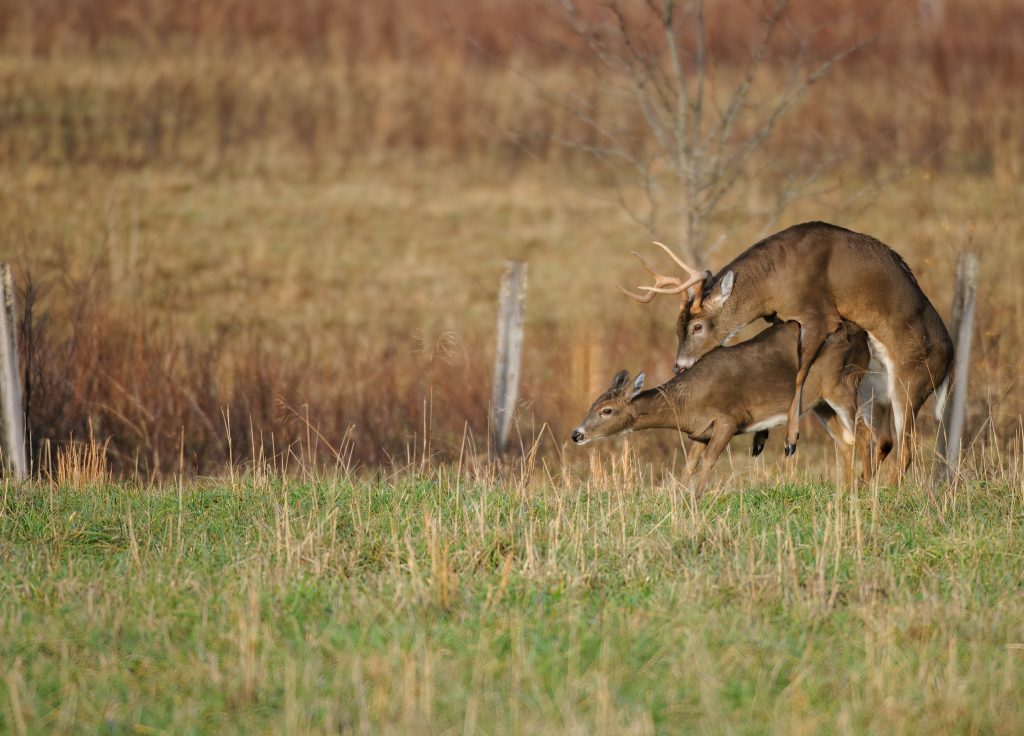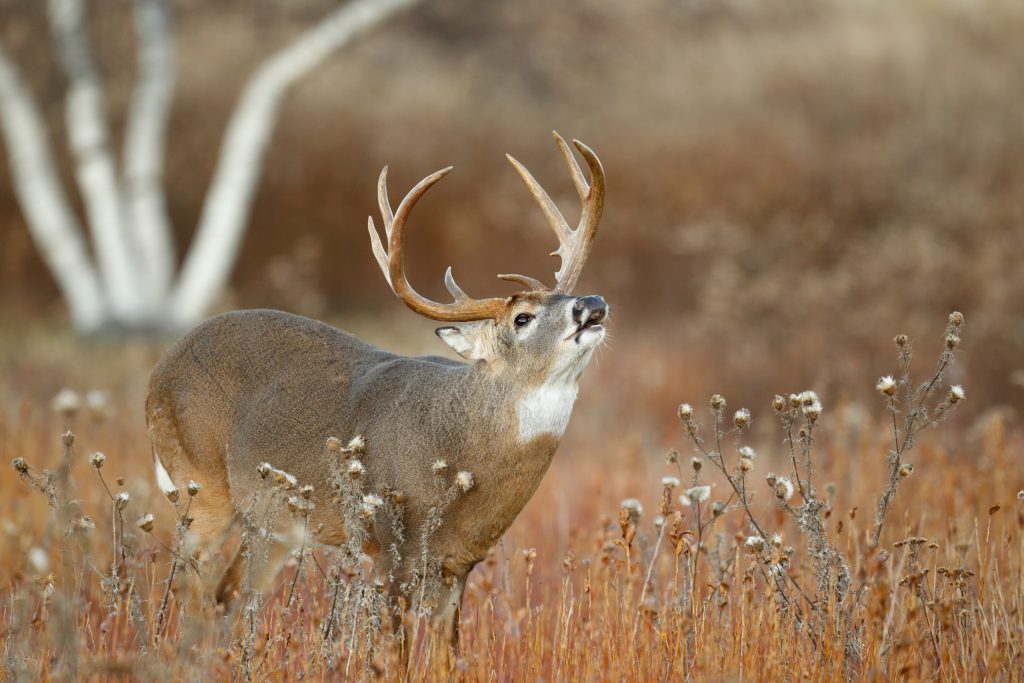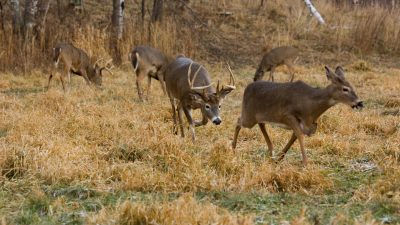While hunting Manitoba back in the 90s, I recall watching several buck fights. Not sparing, where they socially find out where they will rank in the breeding hierarchy, but actual fights with the loser leaving bruised, battered and injured. It wasn’t like a friendly arm wrestling match amongst brothers, which most sparing resembles, these were knock-down, drag-out brawls. Over half of these true “fights” were in the presence of what I assumed was a doe in, or about to come into heat. Most of us believe that the older, larger bucks get to do the majority of the breeding, but is it really true? Do mature bucks control the rut?
Surprising Outcomes: When Smaller Bucks Prevail
During one instance I recall watching a beautiful, massive buck with a160 to 170-inch 5×5 frame and a sizable drop-tine on his right beam come together in combat with an ornery, pudgy 125-inch opponent. I had been hunting the big guy for a couple weeks and was close to letting an arrow fly that morning. I estimated their ages to be five for the drop-tine buck and three for the other buck. The smaller buck cleaned his clock and shortly after I watched the victorious 125-incher breed a doe that had been watching the confrontation. Tenacity, body weight, chance, experience or personality can all make a difference in dominance. It was the belief for years that a small number of dominant bucks breed the majority of does and therefore father the majority of fawns, but big antlers and being mature doesn’t mean they’re dominant. AND, just because they’re dominant doesn’t mean they’ll get breeding rights anyway.
The Influence of Balanced Age Structures on Herd Health

Paul Brown
Aren’t the mature, larger bucks who have worked their way up the dominance ladder supposed to do the breeding? This is what was thought, and there is a bit of truth to it — a balanced age structure and sex ratio is the healthiest for the herd. I must also add that studies vary a bit on this, but you can’t fool DNA. I think most managers would agree that with a balanced population and fairly even sex ratios that the better percentage of breeding is done by the older bucks…the ones who we would think should be doing the breeding. However, many does are bred each year by bucks you wouldn’t think should be worthy of the task.
Why Younger Bucks Often Breed
Besides the fight scenario above, there are several even better reasons why a younger or inferior buck may get to breed. What if a doe comes into heat and there isn’t an older, breeder buck around? Might they get bred by a 1½-year-old buck? Absolutely, this happens! Likely more often than most gamekeepers realize.
Back in the early 2000s, most hunters and gamekeepers would probably have said that within a balanced population only mature bucks would breed, especially if you had fairly even 1:1 to 1:3 buck to doe ratios. The premise of mature, dominant animals doing the majority of the breeding seemed plausible. It wasn’t until the arrival of genetic testing that paternity evaluations could be done. Research during the past few years has shown a much different picture of what actually happens in the whitetail’s breeding world. Move ahead a few years and today we now know that about 35% of all breeding will be done by bucks two years old and younger! It doesn’t matter if there are older-aged bucks around and it doesn’t matter how big the property is or how it’s managed.

Lisa Carter
New Insights from Modern Research
According to one of the biologists I have great respect for, Mark Thomas, (President at Forestry/Wildlife Integration, LLC), “This occurs even when the buck age structure consists of 25% of bucks 1½ years old, 50% between 2½ and 4½ years old, and 25% of bucks 5½ years old or older, which is considered the optimum levels. And, this occurs on small or large private property, industrial tracts, wildlife management areas, and even most enclosures. And it doesn’t matter whether the property is under Traditional Deer Management, Quality Deer Management, or Trophy Deer Management.”
So that all reading understand the difference between Traditional, Quality and Trophy Deer Management, we’ll explain. According to the National Deer Association (NDA), under traditional deer management, any antlered buck is harvested, regardless of age or antler quality, and few does are harvested. This is the strategy that many states still use today. This approach may work when the deer herd is below the habitat’s carrying capacity but fails when the herd equals or exceeds the carrying capacity. Quality deer management is the approach where young bucks are protected from harvest, combined with an adequate harvest of female deer to produce a balance with existing habitat conditions. Trophy deer management is the strategy where only fully mature bucks, five to seven years old, with high scoring antlers are harvested and does are aggressively harvested to maintain low deer density and optimum nutrition for the remaining animals.
Mark Thomas continued saying, “The old school of thought was that the dominant floaters (true social governors of the buck society, or Alpha bucks), dominated the lower class bucks (yearlings, sub-dominate floaters, and primary and secondary fraternal group members), thus preventing them from breeding. Bucks that were 2½ years old and younger were thought to have almost no opportunity to breed. This theory was suggested by researchers studying buck and doe interactions within enclosures mostly. Now, however, studies recently conducted in Mississippi, Texas, and Oklahoma suggest that even when 50% of the bucks are 4-years or older, like on the King Ranch in Texas, the 1 to 2 ½ year old bucks still account for one-third or more of all fawns produced, according to very accurate DNA comparisons.”
Breeding Timing and the Limitations of Dominant Bucks
There are several reasons why it’s common sense that it’s impossible for older class bucks to do the majority of the breeding. Whitetail does come into estrous for around 24 to 36 hours, and through most of the whitetails’ range are usually successfully bred during their first cycle. Most go in to heat in November in the northern portions of their range, and if not successfully bred will cycle again approximately 28 days later. Breeding activity can last into February in their southernmost range.
Seasoned whitetail hunters have heard the term “locked-down” when a buck stays with a hot doe for an extended period. Let’s say the alpha buck in the area searches out a doe and breeds her over a couple days. He will usually stay with her for some time prior to breeding, two days during active breeding, and often for a short period after breeding to defend her from other bucks. During this entire time, this specific buck is preoccupied with one doe. Therefore, other does coming into estrous will likely be bred by other subordinate bucks. Due to the time spent with an individual doe, and because the majority of does in a balanced population are bred over a short time, this strategy doesn’t allow bucks to dominate the breeding.

Tes Jolly
Predator Satiation: Mother Nature’s Strategy

David Kay
You’ve likely seen it before, the rut goes crazy for a period of about a week to ten days and then dwindles. The fact that most does in an area come into heat at almost the same time might be Mother Nature’s grand plan, or natural selection over time. This ensures that most fawns are also born during a short time. This creates “predator satiation.” It is an anti-predator adaptation in which prey occurs at high population densities for a short period, reducing the probability of an individual organism being eaten. There are too many at once, reducing the chances that many will be eaten. When predators are flooded with potential prey, they can consume only a certain amount, so by occurring at high densities all at once prey benefits from a safety in numbers effect. So since the better majority of the does in an area will come into heat very close to one another, it makes it physically impossible for one or a handful of bucks to breed all the does.
The Myth of Dominant Bucks Exclusively Siring Offspring
According to research, other bucks may also breed the same doe after the initial buck moves on searching for another hot doe. This is proven through twins having DNA from two different sires. Statistically, the older, more mature bucks still may breed more does during a season, but many younger bucks will also be active breeders, thus ensuring that all age classes of bucks contribute to the gene pool.
Breeding Numbers and Multi-Sired Fawns
Another very interesting point Thomas pointed out was that the average buck only accounted for three fawns that survived each year. During a six-year period, the most successful breeder studied (according to the DNA tests), only produced a total of 14 fawns – or just over two per year. Confounding the data even more was the fact that 25% of all twins, which are common, had multiple sires. Meaning many does are bred by multiple bucks, it appears.
In Mother Nature’s grand scheme this also makes sense. For the most part, nature is perfect. If only a select small percentage of the males did all of the breeding there would likely be a problem with inbreeding. This doesn’t appear to be a problem through most of the whitetails’ range.
Doe Behavior and the Breeding Process
Does seem to understand when they are ready to conceive. With captive deer, when they come into heat I’ve watched does act panicked, prancing around their pen with their tail cocked off to one side. They make vocalizations that sound like they should be coming out of a sheep in duress rather than a whitetail doe. Some call the sound a “breeding bellow.” But the doe knows, and that sound means “hey baby, I’m ready NOW!” Normally, in the wild, bucks smell when she is becoming ready and will follow her or stay with her until she stands for them. With some captive herds the does aren’t allowed to breed on their first cycle, so as to produce more estrus urine for us hunters to purchase.
Conservation Implications and the Importance of Buck Age

Paul Tessier
So if we’re under the presumption that we should save big antlered bucks or bucks with unique antler characteristics so they pass on their genetics to the upcoming herd, it’s only a crapshoot that it might come true. They likely will pass on their genetics, but not to the extent that most of us thought for years. No one buck dominates the rut.
I will continue to pass young bucks, if for no other reason because “dead deer don’t grow” and I want that individual buck to mature. Over the past 20 years or so, I try to make harvest decisions based on a buck’s age, not simply antler size. I obviously use antler physiognomies as one of the guides in judging age, but try to harvest bucks five years old or older.
Join our weekly newsletter or subscribe to GameKeepers Magazine.
Your source for information, equipment, know-how, deals and discounts to help you get the most from every hard-earned moment in the field.









